|
U.S. Prisoner of War Camps
...
in Memphis and Vicinity -
WWII |
|
|
|
|
 |
During the Second World War, Tennessee was home to eleven
prisoner-of-war camps.
Four were large installations.
Camp Crossville
was built on the site of an abandoned 1930s Civilian
Conservation Corps work camp.
Camp Forrest
was an existing army installation with extra space wherein
prisoners were quartered. Generally, Prisoner of war
facilities were established at army installations throughout
the United States. The Depot at Memphis was one of the
installations in which a camp was located. Initially, it
served as a branch of a camp in Como, Mississippi.
Wounded or ill Prisoners from all over were treated at Memphis
Kennedy Hospital. Information and Photos for this page
were extremely difficult to locate. |
|
|
|
|
|
|
|
|
|
|
|
|
|
|
|
|
Click on small
photos to see an enlargement |
|
|
|
|
|
|
|
|
Memphis ASF
Depot |
|
|
|
The Memphis Army Service Forces Depot was
built as one of the major supply houses for WWII. At its peak,
the depot supplied some 100,000 troops in the South and moved
100,000 items monthly. It handled about one-tenth of all
quartermaster supplies during WWII. When the prisoner of war
camp was established early in 1944 at the depot in Memphis, it was
originally a
branch of the Como, Mississippi camp and housed about 250 Italian
POWs. Around May of 1944, approximately 300 German POWs
replaced them. By September, there were 1,912 prisoners who
were involved with manual labor, mowing, grounds maintenance, and
cafeteria work. Some 800 of the POWs worked in warehouses,
and moved a great deal of the tonnage handled by the depot. The
depot did more than an adequate job of caring for these prisoners.
The camp at the Depot consisted of 4 barracks and 5 tents - with 65 men in each
of the barracks and 6 men in each tent. Half the tents had
wooden floors and some had electric lights.
|
|
|
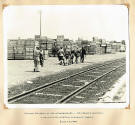 |
 |
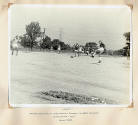 |
 |
 |
|
German
POWS
|
German
POWS |
POWS
play Soccer |
Camp
Currency |
Camp
Currency |
|
|
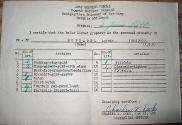 |
 |
 |
 |
 |
|
POW Inventory Items 1946 |
POW Inventory Items |
POW Funeral |
POWs |
POW letter to Memphis |
|
|
|
|
|
|
|
|
|
|
FORREST CAMP, Tennessee
Camp Forrest, near Nashville, officially became a prisoner of war camp in 1942.
It housed Italian and German POWs - over 3000 Germans. The
prisoners became laborers at Camp Forrest in the hospitals and on
the farms in the local community.
|
 |
| |
Camp Forrest |
|
|
|
 |
 |
 |
 |
|
Forrest Gate |
Camp Forrest |
Forrest Tower |
Camp Forrest |
|
|
|
|
|
 |
 |
 |
 |
 |
 |
|
POW Soccer Team |
Xmas Card by POW |
Camp Drawing by POW |
Currency |
POW Letter to
Germany 1944 |
|
|
|
|
|
|
|
|
Camps at CROSSVILLE - CAMPBELL -
CLINTON - SHELBY |
|
|
|
Camp Crossville TN was built on the site of an abandoned 1930s
Civilian Conservation Corps work camp. It was nicknamed "Jap
Camp" by the locals, but it actually contained only Italian and
German prisoners. The first prisoners included about 1500
Germans, most of whom were veterans of General Rommel's Afrika Korps.
Camp Campbell Ky was an existing army installation with extra space.
It was a special-purpose camp which served as a safe haven for
dedicated "anti-Nazi". Discipline at this camp was often a
problem as this group quarreled incessantly among themselves.
Camp Clinton MS housed the highest ranking German Officers. 25
Generals were housed there along with several colonels, majors, and
captians. The high ranking generals had special housing.
Camp Shelby was one of
four base camps in Mississippi. |
|
|
|
 |
 |
 |
 |
|
Crossville Today |
Crossville POW |
Crossville Currency |
Tennessee Camp |
|
|
|
|
|
 |
 |
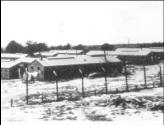 |
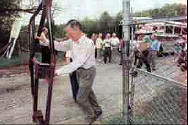 |
|
Clinton,
Mississippi |
Camp Clinton |
Camp Clinton |
Return
to Camp Clinton
|
|
|
|
|
|
 |
 |
 |
 |
|
Shelby Barracks |
Shelby German POWs |
Shelby German Soccer Team |
German POW |
|
|
|
|
|
 |
 |
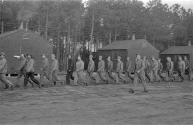 |
 |
|
Camp Campbell |
Camp Campbell |
Camp Campbell |
Camp Campbell |
|
|
|
|
|
|
|
|
Life inside an American POW Camp. |
|
|
|
There were 600 POW camps across
the United States. More than 425,000 German, Italian, and
Japanese POWs were held here during WW2. The majority of
the camps were located in the Southern states. There was
an economical reason for this. Because the weather was
milder, it was less costly to heat the buildings.
Benevolent treatment was
commonplace in American camps and the prisoners were generally
cooperative. They worked, at times, for small wages, when
they were requested to perform labor, mostly of an agricultural
variety. When the cotton compresses and warehouses in
Memphis suffered from a labor shortage in 1944, prisoners from
the Memphis Camp worked there, and some were sent to Arkansas to
pick cotton. |
 |
|
All US
POW Camps |
|
Security at the camps was rather lax. Prisoners were
allowed to go for walks outside the compounds. Most always
returned. Of 356,560 prisoners in the United States, only
1,583 "escaped", and of those only 22 never returned.
Conditions were comfortable and
by the Geneva Convention, the enemy never did without.
Entertainments were commonplace. At Camp Campbell, the
POWs purchased musical instruments from their earnings and
formed two complete orchestras. German prisoners at
Memphis also formed an orchestra. Camp authorities allowed
them to publish newspapers at Crossville and Camp Campbell.
And at some camps, they produced and performed their own German
plays. If there were no disciplinary problems, they were
also even allowed to buy beer and wine. Educational
programs were established at every camp. English
instruction was the most common course.
There is absolutely no doubt
that the prisoners appreciated the kind treatment they received.
They have expressed this in letters and during postwar visits.
Several even emigrated to the areas where they were imprisoned.
In 1984 a group of German prisoners visited Memphis and the site
of their old camp.
The last POW left Memphis for
their return to Germany in 1946. |
|
|
|
|
|
|
|
|
ROHWER Japanese Internment
"Relocation" Camp |
|
|
|
The
Japanese Internment Camps represent another dark moment in American
History. It's a period that is often overlooked in many
textbooks and is unknown to great numbers of people. When the
U.S. went to war with Japan, all Japanese Americans or those of
Japanese descent were rounded up and sent to interment camps on
orders of the United States government, simply for the crime of
their race - for being Japanese. They lost all their property.
And sixty
two percent of the internees were
American
citizens. One of these
camps was established at ROHWER, Arkansas, 115 miles from Memphis.
In 1980 President Jimmy Carter conducted an investigation and the
results were to provide a payment of $20,000 to each individual
internment camp survivor. In 1988 Congress passed legislation
that apologized for the internment on behalf of the U. S.
Government. Eventually the government disbursed more than $1.6
billion in reparations to Japanese Americans who had been interned,
and to their heirs.
|
|
|
|
|
|
|
|
|
|
Credits |
|
|
|
The
Historic-Memphis website does not intentionally post copyrighted
photos and material without permission or credit.
On
occasion a "non-credited" photo might possibly be posted because we
were unable to find a name to give credit. Because of the nature of
our non-commercial, non-profit, educational website, we strongly
believe that these photos would be considered "Fair Use. We have
certainly made no monetary gain, although those using this website
for historic or Genealogy research have certainly profited. If by
chance,
we have posted your copyrighted photo, please contact us, and we'll
remove it immediately, or we'll add your credit if that's your
choice. In the past, we have found that many photographers
volunteer to have their works included on these pages and we'll
also do that if you contact us with a photo that fits a particular
page. |
|
|
|
The "Historic-Memphis" website would like to acknowledge and thank the
following for their contributions which helped make this website
possible:
Collier
County Museums, Woody Savage, Memphis
Public Library, Memphis University Library, Memphis Law Library,
Memphis Commercial Appeal, Memphis Press Scimitar, Shelby County
Register of Deeds, Memphis City Schools, Memphis Business Men's
Club, Memphis Chamber of Commerce, Memphis City Park Commission,
Memphis Film Commision, Carnival Memphis, Memphis Historical
Railroad Page, Memphis Heritage Inc, Beale Street Historic District,
Cobblestone Historic District, Memphis Historic Districts, Vance
Lauderdale Family Archives, Tennessee State Archives, Library of
Congress, Kemmons Wilson Family, Richard S. Brashier, Lee Askew,
George Whitworth, and many individuals whose assistance is
acknowledged on the pages of their contributions. Special
thanks to Memphis Realtor, Joe Spake, for giving us carte blanche
access to his outstanding collection of contemporary Memphis photos.
We do not have high definition copies of the photos on these
pages. If anyone wishes to secure high definition photos,
you'll have to contact the photographer or the collector.
(To avoid any possibility of contributing to SPAM, we do not
maintain a file of email addresses for anyone who contacts us). |
|
|
|
|
|
|
|
|
|
|
|
|
|
|
|
|
|
|
|
|
|
|
| |
|
|
|